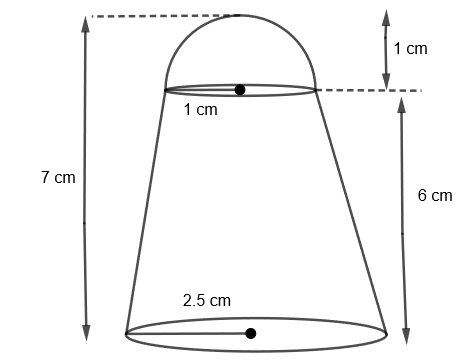
Answer
399k+ views
Hint: First of all, draw the diagram of shuttlecock to visualize the question. Now find the slant height of the cock by using \[l=\sqrt{{{\left( {{r}_{2}}-{{r}_{1}} \right)}^{2}}+{{h}^{2}}}\]. Now, find the external surface area of the shuttlecock by adding the curved surface area of the frustum and hemispherical parts that are \[\pi \left( {{r}_{1}}+{{r}_{2}} \right)l\] and \[2\pi r_{1}^{2}\] respectively where \[{{r}_{1}}<{{r}_{2}}\].
Complete step by step answer:
We are given that a shuttlecock has the shape of the frustum of a cone mounted on the hemisphere. The external diameter of the frustum are 5cm and 2 cm and the height of the entire cock is 7 cm. We have to find the external surface area of the shuttlecock. Let us first see the figure of the shuttlecock.

For the frustum of the shuttlecock, we are given that, radius \[\left( {{r}_{1}} \right)=\dfrac{5}{2}=2.5cm\] and radius \[\left( {{r}_{2}} \right)=\dfrac{2}{2}=1cm\]. Also, the height of the frustum would be h = (7 – 1) = 6 cm. We know that the slant height of the frustum is given by:
\[l=\sqrt{{{h}^{2}}+{{\left( {{r}_{2}}-{{r}_{1}} \right)}^{2}}}\]
By substituting the values of \[{{r}_{1}}\], \[{{r}_{2}}\] and h, we get the slant of the frustum as,
\[l=\sqrt{{{\left( 6 \right)}^{2}}+{{\left( 2.5-1 \right)}^{2}}}\]
\[l=\sqrt{36+2.25}\]
\[l=\sqrt{38.25}\]
\[l=6.18cm\]
We know that the external surface area of the shuttlecock = (curved surface area of the frustum) + (curved surface area of the hemisphere) …..(i)
We know that, the curved surface area of the frustum,
\[F=\pi \left( {{r}_{1}}+{{r}_{2}} \right)l\]
By substituting the values of \[{{r}_{1}}\], \[{{r}_{2}}\] and l, we get,
\[F=\pi \left( 2.5+1 \right).6.18\]
\[=21.63\pi \text{ }c{{m}^{2}}\]
Now, we also know that the curved surface area of the hemisphere,
\[H=2\pi {{\left( {{r}_{2}} \right)}^{2}}\]
By substituting the value of \[{{r}_{2}}\], we get,
\[H=2\pi {{\left( 1 \right)}^{2}}=2\pi \text{ }c{{m}^{2}}\]
Now, by substituting the respective values in the RHS of the equation (i), we get the external surface area of the shuttlecock,
\[S=21.63\pi \text{ }c{{m}^{2}}+2\pi \text{ }c{{m}^{2}}\]
\[\Rightarrow \left( 21.63+2 \right)\pi \text{ }c{{m}^{2}}\]
By substituting the values of \[\pi =\dfrac{22}{7}\], we get,
\[S=23.63\times \dfrac{22}{7}c{{m}^{2}}\]
\[S=74.26\text{ }c{{m}^{2}}\]
Hence, we get the total external surface area of the shuttlecock as \[74.26\text{ }c{{m}^{2}}\].
Note: Students are always advised to draw the diagram first in these types of questions. Also, students should properly do the calculations and take care while putting the decimal in numbers. In this question, some students make this mistake of calculating the total surface area instead of curved surface area, but as we can see that, we only need a curved surface area here to calculate the external area. So this mistake must be taken care of.
Complete step by step answer:
We are given that a shuttlecock has the shape of the frustum of a cone mounted on the hemisphere. The external diameter of the frustum are 5cm and 2 cm and the height of the entire cock is 7 cm. We have to find the external surface area of the shuttlecock. Let us first see the figure of the shuttlecock.

For the frustum of the shuttlecock, we are given that, radius \[\left( {{r}_{1}} \right)=\dfrac{5}{2}=2.5cm\] and radius \[\left( {{r}_{2}} \right)=\dfrac{2}{2}=1cm\]. Also, the height of the frustum would be h = (7 – 1) = 6 cm. We know that the slant height of the frustum is given by:
\[l=\sqrt{{{h}^{2}}+{{\left( {{r}_{2}}-{{r}_{1}} \right)}^{2}}}\]
By substituting the values of \[{{r}_{1}}\], \[{{r}_{2}}\] and h, we get the slant of the frustum as,
\[l=\sqrt{{{\left( 6 \right)}^{2}}+{{\left( 2.5-1 \right)}^{2}}}\]
\[l=\sqrt{36+2.25}\]
\[l=\sqrt{38.25}\]
\[l=6.18cm\]
We know that the external surface area of the shuttlecock = (curved surface area of the frustum) + (curved surface area of the hemisphere) …..(i)
We know that, the curved surface area of the frustum,
\[F=\pi \left( {{r}_{1}}+{{r}_{2}} \right)l\]
By substituting the values of \[{{r}_{1}}\], \[{{r}_{2}}\] and l, we get,
\[F=\pi \left( 2.5+1 \right).6.18\]
\[=21.63\pi \text{ }c{{m}^{2}}\]
Now, we also know that the curved surface area of the hemisphere,
\[H=2\pi {{\left( {{r}_{2}} \right)}^{2}}\]
By substituting the value of \[{{r}_{2}}\], we get,
\[H=2\pi {{\left( 1 \right)}^{2}}=2\pi \text{ }c{{m}^{2}}\]
Now, by substituting the respective values in the RHS of the equation (i), we get the external surface area of the shuttlecock,
\[S=21.63\pi \text{ }c{{m}^{2}}+2\pi \text{ }c{{m}^{2}}\]
\[\Rightarrow \left( 21.63+2 \right)\pi \text{ }c{{m}^{2}}\]
By substituting the values of \[\pi =\dfrac{22}{7}\], we get,
\[S=23.63\times \dfrac{22}{7}c{{m}^{2}}\]
\[S=74.26\text{ }c{{m}^{2}}\]
Hence, we get the total external surface area of the shuttlecock as \[74.26\text{ }c{{m}^{2}}\].
Note: Students are always advised to draw the diagram first in these types of questions. Also, students should properly do the calculations and take care while putting the decimal in numbers. In this question, some students make this mistake of calculating the total surface area instead of curved surface area, but as we can see that, we only need a curved surface area here to calculate the external area. So this mistake must be taken care of.
Recently Updated Pages
10 Examples of Evaporation in Daily Life with Explanations

10 Examples of Diffusion in Everyday Life

1 g of dry green algae absorb 47 times 10 3 moles of class 11 chemistry CBSE

If the coordinates of the points A B and C be 443 23 class 10 maths JEE_Main

If the mean of the set of numbers x1x2xn is bar x then class 10 maths JEE_Main

What is the meaning of celestial class 10 social science CBSE

Trending doubts
Fill the blanks with the suitable prepositions 1 The class 9 english CBSE

Which are the Top 10 Largest Countries of the World?

How do you graph the function fx 4x class 9 maths CBSE

Who was the leader of the Bolshevik Party A Leon Trotsky class 9 social science CBSE

The Equation xxx + 2 is Satisfied when x is Equal to Class 10 Maths

Differentiate between homogeneous and heterogeneous class 12 chemistry CBSE

Difference between Prokaryotic cell and Eukaryotic class 11 biology CBSE

Which is the largest saltwater lake in India A Chilika class 8 social science CBSE

Ghatikas during the period of Satavahanas were aHospitals class 6 social science CBSE




